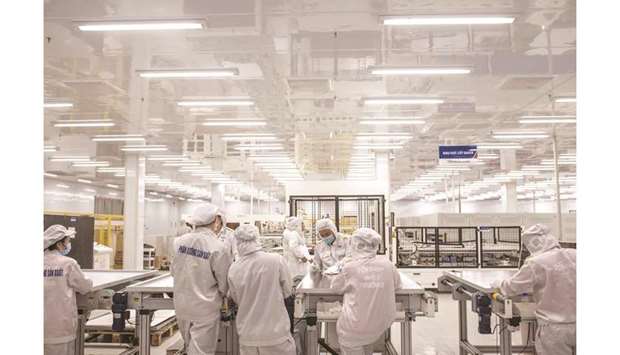Vietnam is finding it hard to win a trade war even when businesses are trying to hand you victories.
The Southeast Asian growth engine has a young and growing middle class, a horde of free-trade agreements, and a booming manufacturing industry.
Businesses from Alphabet Inc’s Google to Crate & Barrel Holdings Inc are lining up to invest in the country as supply chains migrate from neighbouring China, which served as the world’s factory for the better part of two decades. But Vietnam is starting to see expectations outrun reality.
More and more businesses are complaining about congested ports and roads, rocketing costs for land and labour, and regulations that aren’t being loosened fast enough.
Tapestry Inc, owner of the Coach and Kate Spade brands, has lamented insufficient infrastructure investment that’s left some containers stalled on the waters. Eclat Textile Co, a supplier to Nike Inc, says it needs to diversify beyond Vietnam, including to cheaper locations.
If Vietnam isn’t able to fast-track progress in closing its infrastructure gap, it risks losing its “mini-China” status that has drawn so many of Bain & Co’s toy-supplier clients there since 2015, said Gerry Mattios, Bain’s Singapore-based vice president.
Costs could outweigh the benefits, sending producers to the likes of Sri Lanka or Cambodia, he said. For now, the money keeps rolling in.
Total disbursed foreign direct investment rose 6.3% to $12bn in the first eight months of the year from the same period in 2018, according to government figures, with the number of new registered projects surging 25% to 2,406.
Here’s what’s at stake across capacity categories as Vietnam tries to lock in those trade-war wins: Port Congestion Infrastructure is the big challenge for Vietnam, especially at its ports.
China claims six of the top 10 ports by container traffic in the world – including Shanghai at No 1 – while Vietnam’s two biggest ports, Ho Chi Minh Seaport and Cai Mep, rank No 25 and No 50, according to data compiled by Bloomberg Intelligence. Vietnam’s share of global container traffic was just 2.5% in 2017 versus 40% for China.
Shipping container capacity will need to grow at almost twice its 10%-12% pace of the past decade, as well as fold in third-party logistics and freight-forwarding practices to keep up with new demand, BI research shows.
Big-figure deals – around new ports or revamping of old ones – have yet to come to fruition.
Congestion at the ports often means rising inventory costs and less diverse production lines that are limited to non time-sensitive goods, according to the BI analysis.
What would help: massive investments for warehouses, seaports, rail terminals, and inland container depots, for starters. BI also recommends a national or quasi-national container shipping company in order to support large-scale cross-border trade. Demand is certainly growing.
More than 530mn tonnes of cargo were shipped through Vietnam seaports last year, up 20% from a year earlier, according to the Vietnam Maritime Administration’s website.
The volume of exported goods handled rose 15% to 142.8mn tonnes. And 18.1mn TEU of containers were transported last year, up 26% from the previous year. “With the current situation, Vietnam for sure cannot meet the demand of a wave of companies if they move in,” Tsai Wen Jui, chairman of Taiwan-based bicycle saddle manufacturer DDK Group, said in an interview at their Binh Duong office. Even if 5% of Taiwan’s companies in China relocated to Vietnam, the infrastructure would be overwhelmed, he said.
DDK Group has a joint venture with Warburg Pincus-backed Becamex IDC to manage a 200-acre section of the industrial park in Binh Duong province only for Taiwanese companies.
While Tsai said he’s pleased with the quality of the roads inside the park, he bemoans the lack of a highway to deal with traffic that keeps getting more congested. Property Prices Land prices also are a constraint, said Tsai.
The land costs in Bau Bang industrial park have doubled to $80 per square meter from three years ago. The price at some parks in Binh Duong province has increased to $150 per square meter from $65 in 2016, Tsai added. It’s not just Binh Duong that’s seeing some property fever.
Rental prices for industrial property rose by double digits year-on-year in the first half of 2019 for several provinces, including 54.6% in Binh Duong and 31.1% in Tay Ninh, northwest of Ho Chi Minh City. In Hai Duong, east of Hanoi, prices were up 29.4%, according to data compiled by real estate service provider Savills Plc.
Occupancy in these areas has also soared, led by a 63.6% growth rate in Tay Ninh province, the data show.
Residential costs have increased in Hanoi and Ho Chi Minh City, with the former seeing a 20% price jump for condominiums in the second quarter from the previous year, and the latter experiencing a 4% jump on the primary market over the same period.
Vietnam has made strides in the World Bank’s Ease of Doing Business gauge and the World Economic Forum’s Competitiveness Index.
The business-friendly reputation has been helped by investment reforms, privatisation of state-owned entities, and free-trade policies.
Businesses counter that there’s still a way to go to root out corruption, and bureaucratic networks can be tough for outsiders to crack.

Workers clean the surface of solar panels at Irex Energy’s manufacturing facility in Vung Tau, Vietnam. The Southeast Asian growth engine is starting to see expectations outrun reality. More and more businesses are complaining about congested ports and roads, rocketing costs for land and labour, and regulations that aren’t being loosened fast enough.


